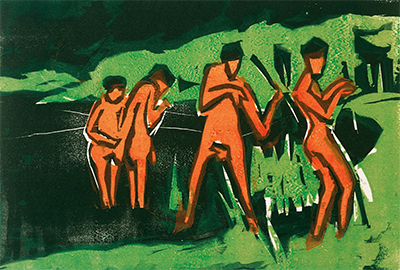 Buy Art Prints Now
Buy Art Prints Nowfrom Amazon
* As an Amazon Associate, and partner with Google Adsense and Ezoic, I earn from qualifying purchases.
The style of this artwork provides a slightly different path for artist Kirchner compared to some of his other more famous figurative paintings. Bathers Throwing Reeds noticeably limits detail down to a minimum, even more aggressively than his other works.
The most obvious explanation for this piece diverging from the norm in terms of style is that it was actually a woodcut as part of a series of two, with one being drypoint, and the other being a woodcut cover. They are both owned by MoMA, who hold a large collection of his artworks from right across a mixture of different art forms. Those looking to delve deeper into his career and find lesser known artworks should check out the collection of Kirchner's work at MoMA. The original title for this piece was Mit Schilf werfende Badende and Kirchner completed it in 1909, with it being published a year later.
Several different versions exist and can be found in collections elsewhere, making it harder to definitely say where the "main" version is located. It is believed that this was one of a number of published artworks that were distributed between like minded artists during this period. Kirchner was not alone in producing expressive art within Germany at this time, though he was clearly one of the figureheads of this collection of creative people. Few built reputations that have lasted as well as his. It is likely that this scene was based around the Moritzburg lakes, which feature in a number of his bathing-themed artworks, which included further woodcuts plus drawings and more complex paintings.
The use of simple forms with clear outlines and a reduced palette with remind many of certain types of African art and this was the inspiration to many Europeans who were involved in what some have termed as the Primitive art movement. This label is not intended as disrepectful, merely pointing to the relatively primitive societies from which the inspirations arrived. Expressive art more generally bears resemblances to art from this region, whilst asian art also provided some technical elements too.




